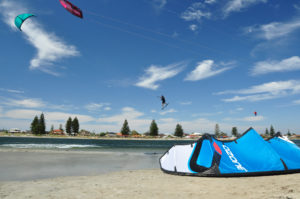In the next fifty years
South Pacific, South Pacific Sailing, Vanuatu — By Kelly on August 10, 2011 8:59 PM“What do you think your home will look like in the next fifty years?“, Infinity Expedition’s volunteer crew ask the people living in the remote villages of Vanuatu in the South Pacific. Without prompting, Barry, resident of Aneityum island in southern Vanuatu, told us the story of how he has recently had to build a new home for his family on higher ground as rising sea levels were coming dangerously close to his old house.
Barry from Aneityum, Vanuatu – his thoughts on what his home will look like in the next fifty years.
James from Aneityum, Vanuatu spoke of the financial consequences of rising sea levels to Mystery Island in Aneityum.
The stick in this photo shows were the sea level ended only two years ago. A sad reality that those who do the least amount to contribute to climate change will and are suffering the most.
Several villagers pointed out the erosion of the land due to rising sea level.
We interviewed the villagers in an effort to give a voice to the people who are affected the most but are so often excluded from discussion because of their location and the difficulty involved in reaching them. The far-reaches of the South Pacific is home to the islands and their cultures are being directly and dramatically impacted by climate change. The “In Fifty Years” project will be a compilation of videos and viewpoints, a look into humanity’s vision of tomorrow.
The mission of Infinity Expedition’s is to promote global awareness, understanding and collaboration, real-world problem solving of environmental issues and choices impacting our planet and its citizens.
Several of the crew of volunteers attending a seminar put on by 350.org while anchored in Fiji. 350.org is a non-profit organization building a global movement to solve the climate crisis.
The crew presented what they learned to the entire group, inspiring all of us to help promote the reality of climate change and inspire others to do their part to help lower the carbon dioxide levels in our atmosphere before it is too late.
The info below is sited from 350.org documents.
 There are three numbers you need to really understand global warming, 275, 390, 350.
There are three numbers you need to really understand global warming, 275, 390, 350.
275 …
For all of human history until about 300 years ago, our atmosphere contained 275 parts per million (ppm) of carbon dioxide.
390 …
The planet currently has 390 parts per million CO2 and this number is rising by about 2ppm every year.
About 300 years ago, humans began to burn coal and oil to produce energy and goods. The amount of carbon in the atmosphere began to rise. Today our everyday activities we are taking millions of years worth of carbon, stored beneath the earth as fossil fuels, and releasing it into the air. At the same time we are changing the way we use our land cutting down trees and tilling our farmland, which also adds CO2 to the atmosphere.
In the last few years, it has become clear that the rise of CO2 in our atmosphere is impacting our planet much faster and more severely than scientists once predicted.
Examples of impacts today:
Glaciers are melting: They are disappearing fast and are the only source of drinking water for hundreds of millions of people.
Sea levels are rising: scientists warn they could go up several meters this century, threatening the homes of hundreds of millions of people.
Mosquitoes are spreading: and are bringing malaria and dengue fever with them.
Weather is more severe: hurricanes, typhoons, droughts are becoming harsher and more frequent.
Oceans are acidifying: warmer and more acidic oceans are killing a vast amount of the world’s coral reefs.
350 …
350 ppm is the safe level of CO2 for our atmosphere. Getting the planet back to the safety zone below 350ppm won’t be easy. We need a worldwide renewable energy revolution, with the whole world working together.
“If humanity wishes to preserve a planet similar to that on which civilization developed and to which life on Earth is adapted, paleoclimate evidence and ongoing climate change suggest that CO2 will need to be reduced from it’s current 389ppm to at most 350 ppm.” Dr. James Hansen, NASA Jan 2008
To see photos of Aneityum Island, CLICK HERE.
Tags: climate change, crewing, environment, global warming, In the Next Fifty Years, Infinity, inspiration, sailing, sailing adventure 2011, vanuatu, volunteer, yacht














0 Comments
You can be the first one to leave a comment.